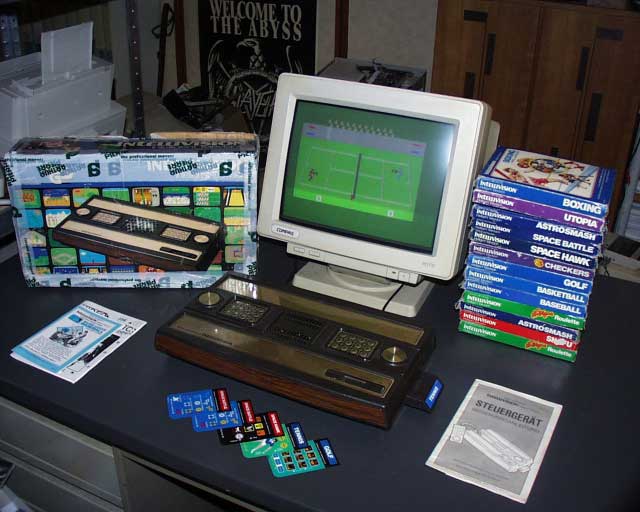At the end of 1979, Mattel Electronics (a division of Mattel Toys) released
a video game system known as Intellivision along with 12 video game cartridges.
Poised as a competitor to the then king of the hill Atari 2600, Mattel
Electronics called their new product "Intelligent Television", stemming
largely from their marketing plans to release a compatible computer keyboard
for their video games console.
Mattel's marketing was anything *but* intelligent and almost destroyed the
company by 1984.
In one sense the system was very successful, with over 3 million units sold and
125 games released before the system was discontinued by INTV Corp. in 1990.
The original Master Component was test marketed in Fresno, California in
late 1979.
The response was excellent, and Mattel went national with their new game
system in late 1980.
The first year's production run of 200,000 units was completely sold out!
To help enhance it's marketability, Mattel also marketed the system in Sears
stores as the Super Video Arcade, and at Radio Shack as the Tandyvision One
in the early 1980's.
1980 was a turbulent year for the Intellivision.
Mattel announced that an "inexpensive" keyboard expansion would be available
in 1981 for the master component to be dropped into.
This was to turn the system into a powerful 64K home computer that could do
everything from play games to balance your checkbook.
There was a great deal of marketing money and press coverage devoted to this
unit; a third of the box for the GTE/Sylvania Intellivision describes the
features of this proposed expansion.
Many people bought an Intellivision with plans to turn it into a computer
when the expansion module was released.
Months, then years passed and the original expansion keyboard was released
only in a few test areas in late 1981.
With the price too high and the initial reaction poor, the product was scrapped
in 1982 before being released nationwide.
1982 saw many changes in both the videogame industry and the Intellivision
product line.
A voice-synthesis module called Intellivoice made sound and speech and integral
part of gameplay, through the use of special voice- enhanced cartridges.
www.thepong.com
-------------------------------------------------------------------------------
Once upon a time, as the 1980s were dawning, Atari more or less had the video
game market to itself.
Then Mattel Toys introduced Intellivision -- Intelligent Television!
The first Intellivision games, produced by an outside software firm, were
so successful that Mattel started a new company -- Mattel Electronics -- to
develop games in-house.
A staff of young, creative, and pretty damn good-looking programmers was hired.
For fear that Atari would try to lure them away, Mattel insisted that their
identities be kept anonymous; they were referred to in publicity as
The Blue Sky Rangers.
In 1982 the video game industry boomed.
The Blue Sky Rangers grew from twenty programmers to well over a hundred at
Mattel's Hawthorne, California headquarters.
Dozens more were hired at Mattel's offices in France and Taiwan.
Scores of companies jumped on the bandwagon, developing games for Atari's,
Mattel's, and newcomer Coleco's game systems.
It seemed that every major company, from 20th Century Fox to Quaker Oats,
had to have its own video game division.
The Blue Sky Rangers themselves, in addition to designing Intellivision games,
developed titles for the Atari 2600, Colecovision, Apple II, IBM PC and
PC Jr., and Mattel's Aquarius computer.
Hundreds of new cartridges and disks hit the market.
Midway through 1983, it all collapsed.
Supply far outpaced demand, stores returned millions of unsold cartridges,
and the industry lost about, oh, one or two billion dollars.
At the January 1984 Consumer Electronics Show in Las Vegas, it was obvious
that video games were dead.
(Just about everyone ignored the new game system introduced by one company;
it was called Nintendo.)
Two weeks after C.E.S., Mattel Electronics was shut down.
Except for a buildingful of accountants and lawyers left behind to clean up
the mess, everybody was laid off.
But Intellivision wouldn't die! The rights to the system were purchased by a
new company, INTV Corporation, started by the former Marketing VP of
Mattel Electronics.
Using Blue Sky Rangers to complete unfinished Mattel games and to create new
ones, INTV continued to release Intellivision games throughout the eighties.
When INTV finally shuttered in 1990, it ended a ten-year-plus run of commercial
production for Intellivision -- the longest support of any cartridge-based
game system!
The Blue Sky Rangers themselves lived on, meeting annually to commemorate the
closing of Mattel Electronics.
Many rode the video game comeback of the late 80s to new success: several
run their own game companies; others are top programmers, artists, designers
and executives, responsible for some of the industry's biggest hits.
And Intellivision still won't die! When the Blue Sky Rangers established this
web site in June 1995, thousands of fans visited, most wondering when they
could play the classic games again.
So Intellivision Productions, Inc. was founded by some of the Blue Sky Rangers
to purchase the rights and develop versions playable on PC and Mac.
Today, the Blue Sky Rangers are still creative and still damn good-looking,
just not quite so young.
But at this site we turn back the clock to those pioneering days -- when the
challenge was to stuff a fun game (and its graphics, music and sound effects)
into 4K.
For those of you who played these games, we hope it triggers some happy
memories.
And for those of you who didn't, we hope you'll try them today!
Enjoy, and thanks for visiting!
www.intellivisionlives.com
|


